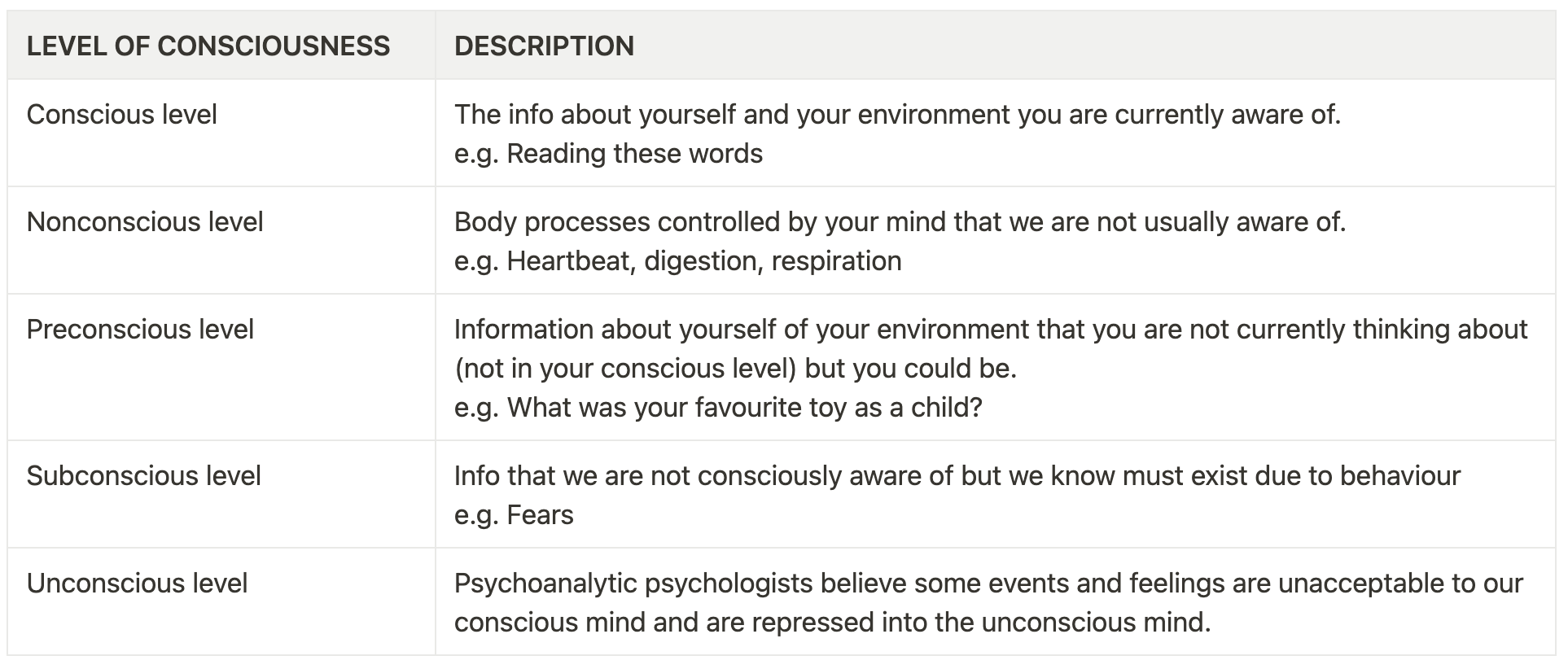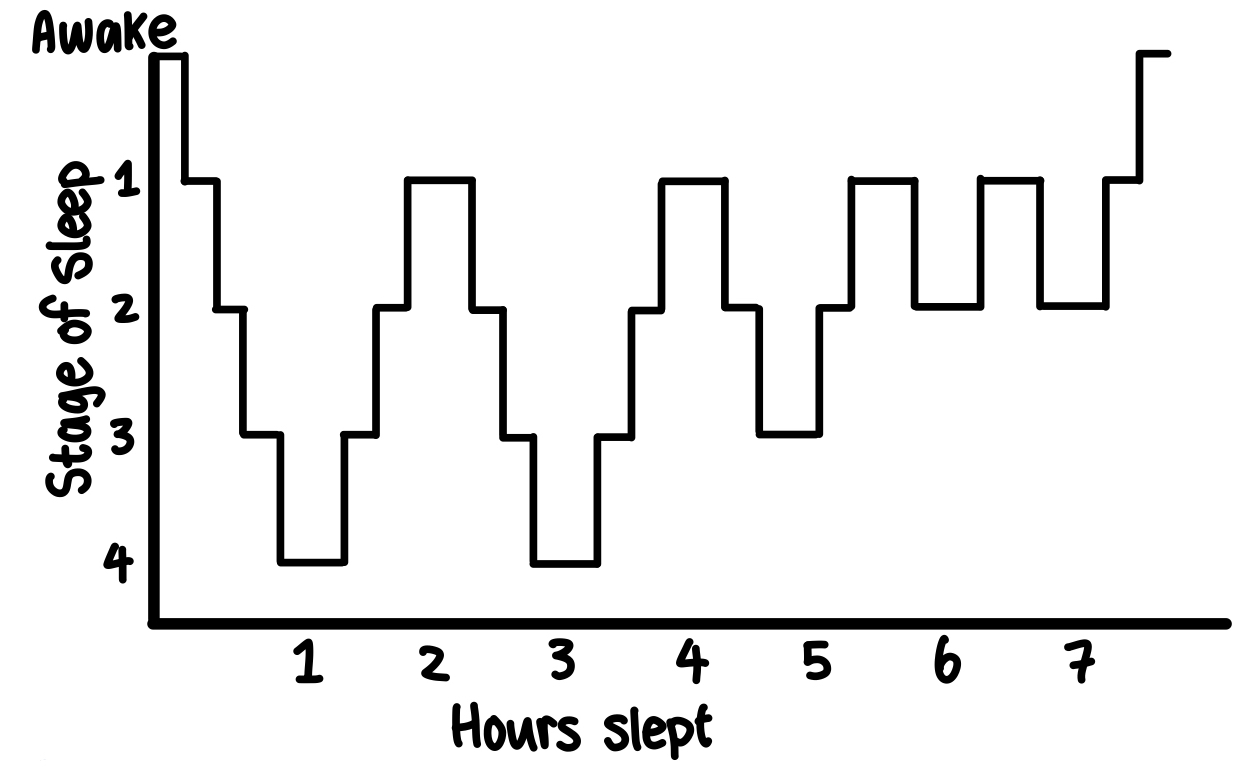
Chap 4: States of Consciousness
Levels of Consciousness
Mere exposure effect
Occurs when we prefer stimuli we have seen before over novel stimuli, even if we do not consciously remember seeing the old stimuli
Priming
Research participants respond more quickly and/or accurately to questions they have seen before, even if they do not remember seeing them
Blind Sight
Some people who report being blind can nonetheless accurately describe the path of a moving object or accurately grasp objects they say they cannot see.
One level of consciousness is not getting any visual information, while another level is able to “see” as demonstrated by their behaviour

Sleep
Circadian Rhythm
A natural, internal process that regulates the sleep–wake cycle and repeats roughly every 24 hours.
EEG machines can record how active our brains are during sleep and describe the different stages of sleep we progress through each night.
The Cycle
Sleep onset - The period when we are falling asleep
Alpha waves are produced when we are drowsy but awake
Between stages 1 and 2, theta waves are produced (high frequency, low amplitude) and they get progressively slower and higher in amplitude
In stage 2, the EEG starts to show sleep spindles which are short burts of rapid brain waves
In stages 3 and 4, delta waves are produced and get progressively slower
Delta sleep is important in replenishing the body’s chemical supplies, releasing growth hormones, and fortifying immune systems.
REM (Rapid Eye Movement) Sleep - Brain activity increases, your eyes dart around quickly, and your pulse, blood pressure, and breathing speed up.
When you do most of your dreaming
REM sleep is important for learning and memory.
Babies spend more time in REM sleep than adults

Sleep Disorders
Insomnia
Most common sleep disorder
Persistent problems getting to sleep or staying asleep at night
Narcolepsy
Much rarer than insomnia
Periods of intense sleepiness and may fall asleep at unpredictable and inappropriate times
Sleep Apnea
Causes a person to stop breathing for short periods of time during the night
Can be fatal if severe
Night Terrors
A sleep disorder in which a person quickly awakens from sleep in a terrified state
Sleep Walking (Somnambulism)
Getting up and walking around while in a state of sleep
Night terrors and sleep walking occur in stage 4 of sleep
Dreams
Sigmund Freud emphasizes dream interpretation as a method to uncover the repressed information in the unconscious mind.
Dreams are wish-fulfilling, meaning that in our dreams we act out our unconscious desires
Manifest content
Literal content of our dreams
Latent content
Unconscious meaning of the manifest content
Protected sleep
Even during sleep, our ego protects us from the material in the unconscious mind by presenting these repressed desires in the form of symbols.
Activation-synthesis theory
Looks at dreams first as biological phenomena
Dreams are nothing more than the brain’s interpretations of what is happening physiologically during REM sleep
Information-processing theory
Stress during the day will increase the number and intensity of dreams during the night
Brain is dealing with daily stress and information during REM dreams
Function of REM is to integrate the info processed during the day into our memories
Drugs
Blood-Brain Barrier
The brain is protected from harmful chemicals in the bloodstream by thicker walls surrounding the brain’s blood vessels
Psychoactive drug molecules are small enough to pass through this barrier
Agonists
Drugs that occupy receptors and activate them like a neurotransmitter
Antagonists
Drugs that occupy receptors but do not activate them
Block receptor activation by agonists
Tolerance
A physiological change that produces a need for more of the same drug in order to achieve the same effect.
Withdrawal
The combination of physical and mental effects a person experiences after they stop using or reduce their intake of a drug
4 categories of drugs: Stimulants, Depressants, Hallucinogens, Opiates

Opiates act as agonists for endorphins
Reverse Tolerance
Hallucinogens may remain in the body for weeks and if an individual ingests the hallucinogen again during this time period, the new dose is added to the lingering amount.
Creates more profound and potentially dangerous side effects.
Chap 4: States of Consciousness
Levels of Consciousness
Mere exposure effect
Occurs when we prefer stimuli we have seen before over novel stimuli, even if we do not consciously remember seeing the old stimuli
Priming
Research participants respond more quickly and/or accurately to questions they have seen before, even if they do not remember seeing them
Blind Sight
Some people who report being blind can nonetheless accurately describe the path of a moving object or accurately grasp objects they say they cannot see.
One level of consciousness is not getting any visual information, while another level is able to “see” as demonstrated by their behaviour

Sleep
Circadian Rhythm
A natural, internal process that regulates the sleep–wake cycle and repeats roughly every 24 hours.
EEG machines can record how active our brains are during sleep and describe the different stages of sleep we progress through each night.
The Cycle
Sleep onset - The period when we are falling asleep
Alpha waves are produced when we are drowsy but awake
Between stages 1 and 2, theta waves are produced (high frequency, low amplitude) and they get progressively slower and higher in amplitude
In stage 2, the EEG starts to show sleep spindles which are short burts of rapid brain waves
In stages 3 and 4, delta waves are produced and get progressively slower
Delta sleep is important in replenishing the body’s chemical supplies, releasing growth hormones, and fortifying immune systems.
REM (Rapid Eye Movement) Sleep - Brain activity increases, your eyes dart around quickly, and your pulse, blood pressure, and breathing speed up.
When you do most of your dreaming
REM sleep is important for learning and memory.
Babies spend more time in REM sleep than adults

Sleep Disorders
Insomnia
Most common sleep disorder
Persistent problems getting to sleep or staying asleep at night
Narcolepsy
Much rarer than insomnia
Periods of intense sleepiness and may fall asleep at unpredictable and inappropriate times
Sleep Apnea
Causes a person to stop breathing for short periods of time during the night
Can be fatal if severe
Night Terrors
A sleep disorder in which a person quickly awakens from sleep in a terrified state
Sleep Walking (Somnambulism)
Getting up and walking around while in a state of sleep
Night terrors and sleep walking occur in stage 4 of sleep
Dreams
Sigmund Freud emphasizes dream interpretation as a method to uncover the repressed information in the unconscious mind.
Dreams are wish-fulfilling, meaning that in our dreams we act out our unconscious desires
Manifest content
Literal content of our dreams
Latent content
Unconscious meaning of the manifest content
Protected sleep
Even during sleep, our ego protects us from the material in the unconscious mind by presenting these repressed desires in the form of symbols.
Activation-synthesis theory
Looks at dreams first as biological phenomena
Dreams are nothing more than the brain’s interpretations of what is happening physiologically during REM sleep
Information-processing theory
Stress during the day will increase the number and intensity of dreams during the night
Brain is dealing with daily stress and information during REM dreams
Function of REM is to integrate the info processed during the day into our memories
Drugs
Blood-Brain Barrier
The brain is protected from harmful chemicals in the bloodstream by thicker walls surrounding the brain’s blood vessels
Psychoactive drug molecules are small enough to pass through this barrier
Agonists
Drugs that occupy receptors and activate them like a neurotransmitter
Antagonists
Drugs that occupy receptors but do not activate them
Block receptor activation by agonists
Tolerance
A physiological change that produces a need for more of the same drug in order to achieve the same effect.
Withdrawal
The combination of physical and mental effects a person experiences after they stop using or reduce their intake of a drug
4 categories of drugs: Stimulants, Depressants, Hallucinogens, Opiates

Opiates act as agonists for endorphins
Reverse Tolerance
Hallucinogens may remain in the body for weeks and if an individual ingests the hallucinogen again during this time period, the new dose is added to the lingering amount.
Creates more profound and potentially dangerous side effects.
 Knowt
Knowt
